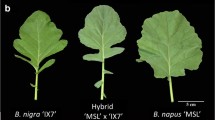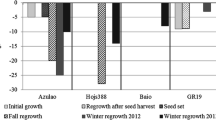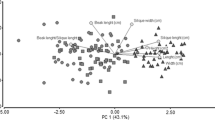Abstract
Spontaneous interspecific hybrids were produced under natural conditions (pollination by wind and bees) between a male-sterile cybrid Brassica napus (AACC, 2n = 38) and two weeds Brassica adpressa (AdAd, 2n = 14) and Raphanus raphanistrum (RrRr, 2n = 18). After characterization by chromosome counts and isozyme analyses, we observed 512 and 3 734 inter-specific seeds per m2 for the B. napus-B. adpressa and B. napus-R. raphanistrum trials respectively. Most of the hybrids studied had the expected triploid structure (ACX). In order to quantify the frequency of allosyndesis between the genomes involved in the hybrids, their meiotic behavior was compared to a haploid of B. napus (AC). For the B. napus-B. adpressa hybrids, we concluded that probably no allosyndesis occurred between the two parental genomes, and that genetic factors regulating homoeologous chromosome pairing were carried by the B. adpressa genome. For the B. napus-R. raphanistrum hybrids, high chromosome pairing and the presence of multivalents (in 9.16% of the pollen mother cells) indicate that recombination is possible between chromosomes of different genomes. Pollen fertility of the hybrids ranged from 0 to 30%. Blackleg inoculation tests were performed on the three parental species and on the interspecific hybrids. BC1 production with the weeds and with rapeseed was attempted. Results are discussed in regard to the risk assessment of transgenic rapeseed cultivation, F1 hybrid rapeseed variety production, and rapeseed improvement.
Similar content being viewed by others
References
Arus P, Orton TJ (1983) Inheritance and linkage relationships of isozyme loci in Brassica oleracea. J Hered 74:405–412
Bing DJ, Downey RK, Rakow GFW (1991) Potential of gene transfer among oilseed Brassica and their weedy relatives. Proc GCIRC Rapeseed Congr, Saskatoon, Canada, 4:1022–1027
Chen KC, Dvorak J (1984) The inheritance of genetic variation in Triticum speltoides affecting heterogenetic chromosome pairing in hybrids with Triticum aestivum. Can J Genet Cytol 26:279–287
Chopinet R (1944) Hybrides intergénériques Raphano-Brassica. La rev Hort 2111:98–100
Delourme R, Eber F, Chèvre AM (1989) Intergeneric hybridization of Diplotaxis erucoides with Brassica napus. I. Cytogenetic analysis of f1 and BC1 progeny. Euphytica 41:123–128
Glimelius K, Fahlesson J, Landgren M, Sjödin C, Sundberg E (1991) Gene transfer via somatic hybridization in plants. Trends Biotechnol 9:24–30
Harberd DJ, McArthur ED (1980) Meiotic analysis of some species and genus hybrids in the Brassiceae. In: Tsunoda F, Hinata K, Gomez-Campo C (eds) Brassica crops and wild allies, biology and breeding. Japan Scientific Societies Press, Tokyo, pp 65–87
Heyn FW (1976) Transfer of restorer genes from Raphanus to cytoplasmic male-sterile Brassica napus. Cruciferae Newslett 1:15–16
Heyn FW (1977) Analysis of unreduced gametes in the Brassicaceae by crosses between ploidy levels. Z Pflanzenzuecht 78:13–30
Kamra OP (1960) Chromatin extrusion and cytomixis in pollen mother cells of Hordeum. Hereditas 46:592–600
Karpechenko GD (1924) Hybrids of Raphanus-Brassica oleracea. J Genet 14:3
Kerlan MC, Chèvre AM, Eber F, Baranger A, Renard M (1992) Risk assessment of outcrossing of transgenic rapeseed to related species. I. Interspecific hybrid production under optimal conditions with emphasis on pollination and fertilization. Euphytica 62:145–153
McNaughton IL (1973) Synthesis and sterility of Raphanobrassica. Euphytica 22:70–88
Mizushima U (1980) Genome analysis in Brassica and Allied Genera. In: Tsunoda F, Hinata K, Gomez-Campo C (eds) Brassica crops and wild allies, biology and breeding. Japan Scientific Societies Press, Tokyo, pp 89–106
Namai H (1987) Inducing cytogenetical alterations by means of interspecific and intergeneric hybridization in Brassica crops. Gamma Field Symp 26:41–88
Pellan-Delourme R, Renard M (1988) Cytoplasmic male sterility in rapeseed (Brassica napus L.): Female fertility of restored rapeseed with “Ogura” and cybrid cytoplasm. Genome 30:234–238
Pelletier G, Primard C, Vedel F, Chétrit P, Remy R, Rousselle P, Renard M (1983) Intergeneric cytoplasmic hybridization in Cruciferea by protoplast fusion. Mol Gen Genet 191:244–250
Prakash S, Hinata K (1980) Taxonomy, cytogenetics and origin of crops Brassicas, a review. Opera Bot 55:1–57
Renard M, Dosba F (1980) Etude de l'haploïdie chez le colza (Brassica napus L. var oleifera Metzger). Ann Amelior Plant 30:191–209
Roy NN (1978) A study on disease variation in the populations of an interspecific cross of Brassica juncea L. x B. napus L. Euphytica 27:145–149
Salesses G (1970) Sur le phénomène de cytomyxie chez des hybrides triploïdes de pruniers. Conséquences génétiques possibles. Ann Amélior Plant 20:383–388
Sears ER, Okamoto M (1958) Intergenomic chromosome relationships in hexaploid wheat. Proc 10th Int cong Genet 2:258
Shield CR, Orton TJ, Stuber CW (1983) An outline of general resource needs and procedures for the separation of active enzymes from plant tissue. In: Tanksley SD, Orton TJ (eds) Isozymes in plant genetics and breeding. Elsevier Science Publishers, Amsterdam, pp 443–468
Song KM, Osborn TC, Williams PH (1988) Brassica taxonomy based on nuclear restriction fragment length polymorphisms (RFLPs). 1. Genome evolution of diploid and amphidiploid species. Theor Appl Genet 75:784–794
Takeshita M, Kato M, Tokumasu S (1980) Application of ovule culture to the production of intergeneric or interspecific hybrids in Brassica and Raphanus. Jpn J Genet 55:373–387
Vallejos CE (1983) Enzyme activity staining. In: Tanksley SD, Orton TJ (eds) Isozymes in plant genetics and breeding. Elsevier Science Publishers, Amsterdam, pp 469–516
Warwick SI, Black LD (1991) Molecular systematics of Brassica and allied genera (Subtribe Brassicinae, Brassiceae) — chloroplast genome and cytodeme congruence. Theor Appl Genet 82:81–92
Williams PH, Delwiche PA (1979) Screening for resistance to blackleg of crucifers in seedling stage. Proc Eucarpia Conf on the breeding of cruciferous crops, Wageningen, pp 164–170
Author information
Authors and Affiliations
Additional information
Communicated by Y. Gleba
Rights and permissions
About this article
Cite this article
Eber, F., Chèvre, A.M., Baranger, A. et al. Spontaneous hybridization between a male-sterile oilseed rape and two weeds. Theoret. Appl. Genetics 88, 362–368 (1994). https://doi.org/10.1007/BF00223646
Received:
Accepted:
Issue Date:
DOI: https://doi.org/10.1007/BF00223646




